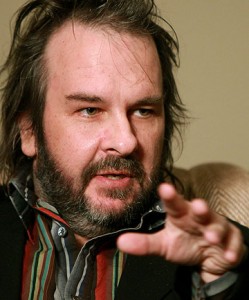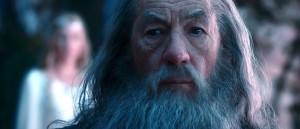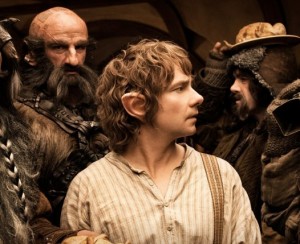 Many fans are eagerly anticipating a return to the fictional world of Middle-earth with next week’s general release of the first movie in “The Hobbit” trilogy. Director Peter Jackson and the film’s stars speak to The Associated Press about making “The Hobbit: An Unexpected Journey”.
Many fans are eagerly anticipating a return to the fictional world of Middle-earth with next week’s general release of the first movie in “The Hobbit” trilogy. Director Peter Jackson and the film’s stars speak to The Associated Press about making “The Hobbit: An Unexpected Journey”.
Jackson on shooting at 48 frames per second instead of the standard 24: “We’ve seen the arrival of iPhones and iPads and now there’s a generation of kids – the worry that I have is that they seem to think it’s OK to wait for the film to come out on DVD or be available for download. And I don’t want kids to see `The Hobbit’ on their iPads, really. Not for the first time. So as a filmmaker, I feel the responsibility to say, `This is the technology we have now, and it’s different … How can we raise the bar? Why do we have to stick with 24 frames? …'”
“The world has to move on and change. And I want to get people back into the cinema. I want to play my little tiny role in encouraging that beautiful, magical, mysterious experience of going into a dark room full of strangers, and being transported into a piece of escapism.”
Martin Freeman (Bilbo Baggins) on shooting some scenes without other actors around: “I must admit I found the green screen and all that easier than I thought I would. … I found the technical aspect of it quite doable. Some of it’s difficult, but it’s quite enjoyable, actually. It taps into when I used to play `war’ as a 6-year-old. And the Germans were all imaginary. Because I was playing a British person. So yeah, I was on the right side. …”
On marrying his performance to that of Ian Holm, who played an older Bilbo Baggins in the “Lord of the Rings” trilogy: “I knew I couldn’t be a slave to it. Because as truly fantastic as Ian Holm is in everything, and certainly as Bilbo, I can’t just go and do an impression of Ian Holm for a year and a half. Because it’s my turn. But it was very useful for me to watch and listen to stuff he did, vocal ticks or physical ticks, that I can use but not feel hamstrung by.”
[Read More]
Posted in:
Share:

 How did Peter Jackson turn one small book into another massive film trilogy? Simple: all it took was some imagination and a bit of help from the author of The Hobbit himself.
How did Peter Jackson turn one small book into another massive film trilogy? Simple: all it took was some imagination and a bit of help from the author of The Hobbit himself.
The director has taken heat for turning what was intended to be a two-part prequel to his Lord of the Rings series into a three-part saga, especially given that the first Hobbit film clocks in at nearly three hours. Unlike the LOTR books, The Hobbit is a thin volume written for children, leading some to accuse him of stretching out narrative and milking the franchise. Instead, Jackson contends that the brevity of the book actually helped make it possible.
“The book is written in a very brisk pace, so pretty major events in the story are covered in only two or three pages,” Jackson told reporters on Wednesday. “So once you start to develop the scenes and plus you wanted to do a little bit more character development, plus the fact that we could also adapt the appendices of Return of the King, which is 100-odd pages of material that sort of takes place around the time of The Hobbit, so we wanted to expand the story of The Hobbit a little bit more, as did Tolkien himself. So all those factors combined gave us the material to do it.”
The appendices, which were tacked onto the final book of the Lord of the Rings series, fill in many blanks that were left in The Hobbit, which co-screenwriter Philippa Boyens pointed out.
“If we hadn’t done The Lord of the Rings, we wouldn’t have had done this. But we did,” she said. “We know where Gandalf was. So as soon as we knew we were going to that part of the tale, what happens in those years, because we knows what happens because Tolkien kept writing, you start to draw in and make a mythology.”
Series newcomer Richard Armitage, who plays the lead dwarf Thorin, chalked it up to the entire saga’s deep subtext.
[Read More]
Posted in:
Share:

 There’s some food for thought in this analysis on Yahoo! News of the high-frame-rate technology that Peter Jackson has deployed in The Hobbit. It may (or may not!) be useful in helping you make your own mind up. Also worth noting that they asked TORn’s Calisuri to expand a little more on his thoughts on HDR from his review. Continue reading “Super-clear format can puncture Hobbit fantasy”
There’s some food for thought in this analysis on Yahoo! News of the high-frame-rate technology that Peter Jackson has deployed in The Hobbit. It may (or may not!) be useful in helping you make your own mind up. Also worth noting that they asked TORn’s Calisuri to expand a little more on his thoughts on HDR from his review. Continue reading “Super-clear format can puncture Hobbit fantasy”
Posted in:
Share:

 For those of you who couldn’t catch The Colbert Report’s Hobbit Week, TheOneRing.net has assembled links to clips from the shows. Steven Colbert, a self-professed Tolkien uber-geek, dedicated this past week to interviewing cast members from the upcoming Hobbit movie. Interviews included Martin Freeman, Andy Serkis, Sir Ian McKellen, Elijah Wood, and director Peter Jackson himself. Follow the links below to see all five spots, but beware that it’s been reported there may be a spoiler or two!
For those of you who couldn’t catch The Colbert Report’s Hobbit Week, TheOneRing.net has assembled links to clips from the shows. Steven Colbert, a self-professed Tolkien uber-geek, dedicated this past week to interviewing cast members from the upcoming Hobbit movie. Interviews included Martin Freeman, Andy Serkis, Sir Ian McKellen, Elijah Wood, and director Peter Jackson himself. Follow the links below to see all five spots, but beware that it’s been reported there may be a spoiler or two!
Andy Serkis (interview begins at 14:30)
Peter Jackson (interview begins at 15:08)
Sir Ian McKellen
Elijah Wood
Martin Freeman
Posted in:
Share:

Ever wondered exactly what they do at Weta Workshop and Weta Digital? Richard Taylor talks about their work in this neat little clip. Plus there’s some footage and red carpet interviews from the Wellington premiere of The Hobbit: An Unexpected Journey that you may not have sen previously. Continue reading “Richard Taylor talks about Weta’s work”
Posted in:
Share:

Courtesy of Warner Bros Belgium, here is an amazing 13-minute look into The Hobbit: An Unexpected Journey. It features behind-the-scenes footage, interviews with Philippa Boyens, Peter Jackson, Martin Freeman, Richard Armitage and many, many other key cast and crew members where they discuss the inspiration for, and direction of, the story the first film reveals. Plus there’s plenty of new, previously unseen (at least by me!) sneak previews of what you’ll see on the big screen! So I guess I’ll add: spoilers! Continue reading “The Hobbit: An Unexpected Journey – 13-minute TV special!”
Posted in:
Share:

 Many fans are eagerly anticipating a return to the fictional world of Middle-earth with next week’s general release of the first movie in “The Hobbit” trilogy. Director Peter Jackson and the film’s stars speak to The Associated Press about making “The Hobbit: An Unexpected Journey”.
Many fans are eagerly anticipating a return to the fictional world of Middle-earth with next week’s general release of the first movie in “The Hobbit” trilogy. Director Peter Jackson and the film’s stars speak to The Associated Press about making “The Hobbit: An Unexpected Journey”. 




